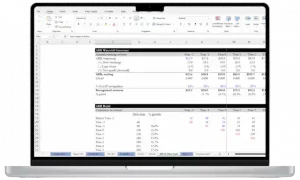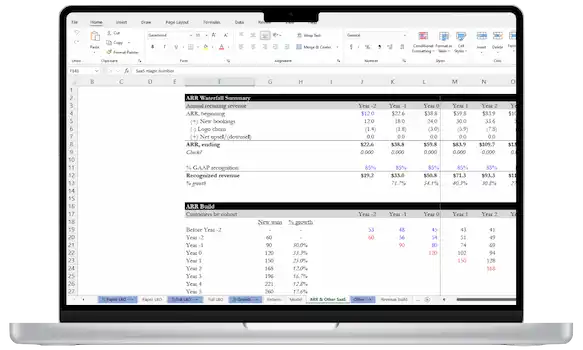What is net revenue retention?
Net revenue retention (NRR) measures how much monthly recurring revenue (MRR) from existing customers has changed in a given accounting period, usually a year.
NRR is an important SaaS metric because it measures how well a company can not only retain its existing customers, but make them more individually valuable to the company over time.

How to calculate net revenue retention rate
To calculate NRR, you begin with the MRR from the start of the period. As a reminder, MRR is monthly recurring revenue and is a component of annual recurring revenue (ARR).
You must add expansion MRR to beginning MRR and subtract churn to get the overall change in MRR and the ending MRR for the period.
NRR is the comparison, expressed as a percentage, of the ending and beginning MRR.
NRR = (Beginning MRR + Expansion MRR from existing clients – Churned MRR from existing clients) / Beginning MRR
Note that this calculation does not include new MRR from new customers during the period. It only includes expansion MRR, which consists of upsells or cross-sells from existing customers.
Net revenue retention (NRR) vs. net dollar retention (NDR)
Many investors and companies use these two terms interchangeably.
There is one slight nuance to be aware of, though:
- Net revenue retention, as defined above, measures the growth in value of all existing customers over a period of time, usually a year.
- Net dollar retention is often used to measure the growth in value of one single customer over a period of time
Personally, I would still use them interchangeably, and doing so would be incorrect. However, I wanted readers to be aware that some in the industry use this distinction.
This difference, between total customers and individual accounts, means that the two statistics can be used in very different ways:
- Net revenue retention can give you a good idea of how your company is doing as a whole to keep your customers satisfied and valuable. Net dollar retention can be used to drill down into NRR to individual customer behavior patterns.
- Larger enterprise clients, for example, may behave differently than small businesses or individuals who use your software. NDR can be a more useful way to show these individual behavior patterns.
Why is net revenue retention important?
Net revenue retention shows how well your existing customers ultimately value your offerings.
Satisfied customers who trust your product are much more likely to stay with your company, and, more importantly, continue to make new purchases or upgrades.
Focusing on NRR as a success metric forces your company to do two key things:
- It forces focus on providing customer value: Since NRR is based solely on existing customes, it places the emphasis on retaining existing customers through excellent service, an excellent product, and high levels of customer trust. While bringing in new business is also important, NRR focuses on the company’s most important asset: its existing customers.
- It forces focus on high value upsells: To maintain good NRR, your sales and customer service teams need to work together to make sure customers are served well. Selling an upgrade package or a more expensive subscription to your customer won’t increase NRR if it’s not what your customer really needs over the long-term. Upselling or cross-selling your services in a way that truly benefits the client is what will rocket your NRR rate to new heights over the long-run. In this way, it provides great alignment between a customer’s sales team and its customers.
Lastly, it should be mentioned that net revenue retention rate is important because acquiring new customers is typically the most expensive and hardest sale to make. Whereas, if you can hold onto the customers you already have – and even better, sell more to them over time – your company has a great chance to be financially successful since this revenue will be cost-effectively acquired.
Like the Rule of 40 and other SaaS metrics, the net revenue retention rate is a metric that can be applicable in essentially all phases of a company’s lifecycle after inception.
What is a good net revenue retention rate?
An NRR rate above 100% means that the company will continue to grow and be profitable even with no new customers. This is because NRR does not include new customer data from the period.
If the existing customers stay (low churn), and continue to upgrade their memberships, subscriptions, or add-ons every year, you have a high quality SaaS company.
The “holy grail” of NRR has typically been around 125%. Reaching this level means the company provides exceptional value to customers, customer have high satisfaction, and the company’s product and sales teams are executing well.
Having high NRR rates means another key thing: you will be able to spend less on outbound marketing costs. A loyal customer base means more word-of-mouth referrals, and low churn means your company is remaining profitable without constantly searching for new customers.

- 33 lessons
- 8+ video hours
- Excels & templates
How to improve your net revenue retention
A SaaS company can improve its net revenue retention by focusing on expansion MRR and churn rate.
If you have low expansion MRR, you have customers that stay with you, but are unwilling to spend more money with you. You will have to find out the answer to why that is.
- Are they in a low-income demographic? Consumers, solopreneurs, and small business owners may be less likely to spend money than large business clients.
- Are they simply satisfied with the value you offer at their current price? You may have to change your messaging to help your customers understand the added value you could provide to them at a higher price point.
- Do your customers understand the full value of your services? Without a quality onboarding experience, new customers may not fully understand how your service can make their lives easier. User guides, tutorials, and easy onboarding will all help your customers to see exactly how to use your software to get the most value out of it.
- Are customers at risk of churning? Existing unsatisfied customers will not want to spend more money on your products than they already do. Measuring the health of individual customer accounts can identify customers who are likely to churn, and customer success teams can help forestall churn before it occurs.
Periodically collecting customer feedback across your website and software products can also help reduce customer frustration and churn rates. The answers to a simple “Was this helpful?” can go a long ways toward showing you what your customers need, and what they are struggling with in your software.
- Do you have the cross-sell products that provide value to customers? If you only offer a small variety of software solutions, you will not have as many opportunities to expand your NRR as a company with more offerings. While increasing your offerings may mean uncomfortable internal changes or growth, it can pay large dividends if your company can become a “one-stop-shop” for your customers’ software solution needs.
Not sure what they need? Think about what product they might need before yours, or after yours. This can give you a good idea of how to make related software products that will attract your customers’ interest.
- Are you making the most of free trials? Most companies reserve free trials for new customers. Expanding this to offer existing customers a free trial of a premium plan can show them how the higher level of service could make their work easier. Or, you could send regular reminders to your customers about features they haven’t unlocked yet in side-by-side or higher-level offerings.
FAQ: What does it mean if net revenue retention is above 100%?
A net retention rate over 100 means that period-end monthly recurring revenue is greater than beginning period MRR.
This is a sign that the company is making more revenue period-over-period from its existing customers. If the company is remaining profitable and continuing to make more money from its existing customers, it has less need to continually search for new customers. It is much more expensive to find and onboard a new customer than to sell to an existing one, so a high NRR has the hidden benefit of reducing marketing and onboarding costs over time.
On the other hand, a net retention rate rate below 100 means that period-end MRR is less than beginning MRR, and the company is losing its existing customer revenue. This is most likely because the churn rate is too high, and the customers that do stay are not buying any new subscriptions or upgrades. NRR below 100 means that the company must continually bring in new customers to maintain or raise its current revenue.
The “gold standard” for NRR is around 125%. This shows that the company has a healthy customer base that continues to come back for more. There is low churn, and the customers are happy to regularly upgrade their subscriptions or buy additional products.
FAQ: What is the average net revenue retention for SaaS companies?
NRR rates for SaaS companies can vary wildly, from as low as 60% to as high as 148%.
Companies that have annual contract rates tend to have higher NRR than companies with monthly subscriptions, and companies that sell B2C tend to have lower NRR than B2B SaaS companies.
FAQ: What is the difference between NRR and MRR?
Net retention revenue analyzes monthly recurring revenue (MRR) over multiple periods. NRR also only looks at existing customers, and does not take new customer acquisition into account.
MRR looks at the entire recurring revenue base company. It includes all MRR from newly acquired customers. How much of the company’s revenue is recurring, subscription-based revenue? Are we using good subscription models and not relying too much on one-time revenue sources? How can we increase MRR with new customers?
NRR is useful to look at over time; how much of the company’s current MRR will we have next year? In five years? How can we increase MRR year-over-year, even with no additional customers? How can we increase value for the customers we already have?
If a company only looks at MRR as a success metric, it may miss the fact that lots of new customer acquisition is masking the company’s high underlying churn rates.
If a new SaaS company needs to expand its customer base, this may appear to decrease NRR for a while, as the company is always adding new revenue that NRR does not reflect. However, NRR will show the high churn rate if there is one, and force the company to focus on making its existing customers more valuable to the business.
Both NRR and MRR have their place as SaaS success metrics, but NRR can show a more complete picture of customer satisfaction alongside revenue growth than MRR can.
Conclusion
NRR is one of the top metrics for SaaS companies, both for company CEOs and for investors. It gives a quick look at the overall health of the company in key areas: product value proposition, salesforce effectiveness, and potential for revenue growth. Since these are so closely tied together for SaaS companies, using NRR as a success metric makes a lot sense.
Go deeper on other SaaS metrics in my article series, or check out my full online course to achieve mastery in SaaS metrics and financial modeling.


 SaaS & Growth Metrics
SaaS & Growth Metrics Break Into Growth Equity
Break Into Growth Equity
